Trees Birds Mammals Fish Amphibians Reptiles
Wild Algarve
Bookshop
Cyclocybe erebia (Fr.) Singer - Dark Fieldcap
Phylum: Basidiomycota - Class: Agaricomycetes - Order: Agaricales - Family: Strophariaceae
Distribution - Taxonomic History - Etymology - Identification - Culinary Notes - Reference Sources
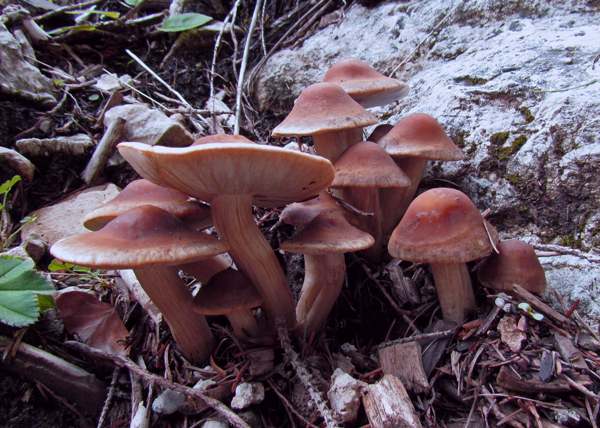
An occasional find but then often gregarious, the Dark Fieldcap, Cyclocybe erebia, is a woodland fungus; its cap colour is very variable, sometimes with a centre so dark that it appears to be almost jet black. (The rings are not yet evident because the partial veils are still intact in the young and untypically lightish brown specimens shown here.)
Many of the fieldcaps can have darkish caps when young, but Agrocybe erebia is the only one that remains mid to dark brown through to maturity rather than fading to buff.
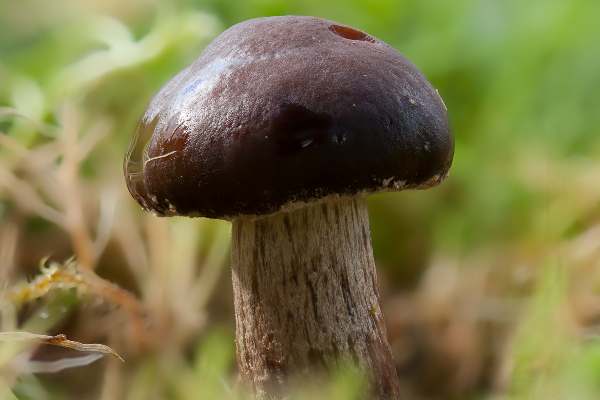
Distribution
An uncommon find in most parts of Britain and Ireland, Cyclocybe erebia occurs also throughout mainland Europe and in North America.
Taxonomic history
When Christiaan Hendrik Persoon described this mushroom in 1801 he named it Agaricus denigratus, which twenty years later the great Swedish mycologist Elias Magnus Fries changed to Agaricus erebius. Until m2014 its accepted scientific name was Agrocybe erebius, which dated from 1939, when German-born mycologist Rolf Singer transferred it to the genus Agrocybe. Based on the results of recent DNA analysis, in 2014 Italian mycologist Alfredo Vizzini and American P. Brandon Matheny transferred it to the genus Cyclocybe, establishing the currently-accepted scientific name Cyclocybe erebia.
Synonyms of Cyclocybe erebia include Agaricus denigratus Pers., Agaricus erebius Fr., Agaricus leveillianus Dozy & Molk., Agaricus jecorinus Berk. & Broome, Armillaria denigrata (Pers.) P. Kumm., Pholiota erebia (Fr.) Gillet, Togaria erebia (Fr.) W.G. Sm., and Agrocybe erebia (Fr.) Singer.
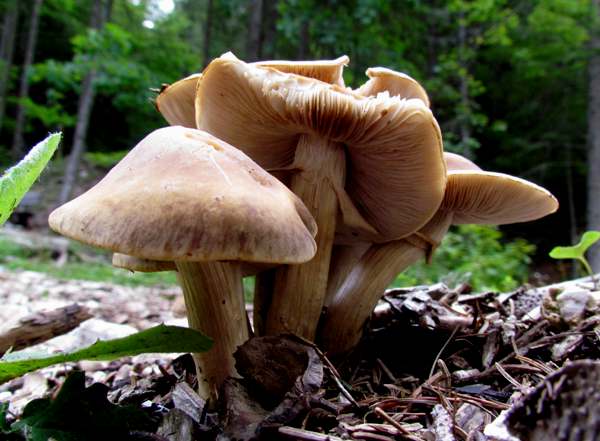
Etymology
Not all fieldcap fungi occur in open fields, and the Dark Fieldcap is definitely a mushroom of field margins, hedgerows, woodlands and other shady places near trees. 'Fieldcap' is derived from Agro-, of fields, and -cybe, head or cap, and is therefore a direct translation of the generic name Agrocybe. The specific epithet erebia simply means 'dark'.
Identification guide
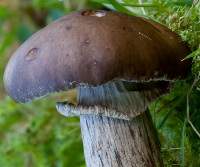 |
Cap
4 to 7cm across, hemispherical becoming broadly umbonate; the mid to dark brown cap surface usually pales somewhat towards the margin but does not fade, as other fieldcaps do, at maturity. |
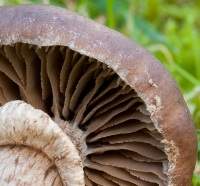 |
Gills
Adnate or very slightly decurrent; initially pale brown, turning dark brown as the spores mature.
Stem
5 to 10cm long and 0.7 to 1.2cm diameter; cylindrical; whitish streaked with brown, darker towards base; retaining a persistent, pendulous pale brown ring with radial striations. |
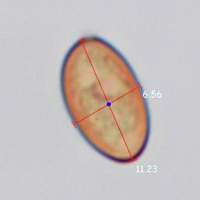 |
Spores
Ellipsoidal, smooth, 9.5-13 x 5.5-7.1µm, with a shallow snout-like protrusion.
Spore print
Dark brown. |
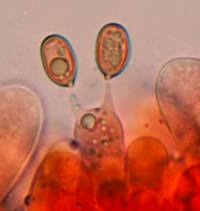 |
Basidia
Usually with two spores per basidium. |
Odour/taste |
Not distinctive. |
Habitat & Ecological role |
In tufts or small groups, rarely solitary, saprobic on the litter of hardwood and softwood forest floors, hedgerows and sometimes under trees in parkland; occasionally on well-rotted woodchip mulch. |
Season |
June to October in Britain and Ireland. |
Similar species |
Agrocybe praecox, which occurs in
spring and early summer, often grows in woodchip mulch; it is typically smaller than Agrocybe erebia and usually has a yellowish buff cap that becomes even paler with age. |
Culinary Notes
Agrocybe erebia is easily confused with any number of seriously poisonous brownish mushrooms - for example Hebeloma mesophaeum - and so is best considered inedible and therefore avoided when gathering mushrooms to eat.
Reference Sources
Fascinated by Fungi, 2nd Edition, Pat O'Reilly 2016, reprinted by Coch-y-bonddu Books in 2022.
BMS List of English Names for Fungi
Marcel Bon, 1980: Revision du Genre Agrocybe Fayod. Bulletin trimestriel de la Fédération Mycologique Dauphiné-Savoie, 76: 32-36. Bulletin de la Fédération trimestriel Mycologique Dauphiné-Savoie, 76: 32-36.
Funga Nordica: 2nd edition 2012. Edited by Knudsen, H. & Vesterholt, J. ISBN 9788798396130
Dictionary of the Fungi; Paul M. Kirk, Paul F. Cannon, David W. Minter and J. A. Stalpers; CABI, 2008
Taxonomic history and synonym information on these pages is drawn from many sources but in particular from the British Mycological Society's GB Checklist of Fungi.
Acknowledgements
This page includes pictures kindly contributed by David Kelly.
Top of page...
Fascinated by Fungi. Back by popular demand, Pat O'Reilly's best-selling 450-page hardback book is available now. The latest second edition was republished with a sparkling new cover design in September 2022 by Coch-y-Bonddu Books. Full details and copies are available from the publisher's online bookshop...